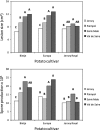Long-distance gene flow outweighs a century of local selection and prevents local adaptation in the Irish famine pathogen Phytophthora infestans
- PMID: 24822079
- PMCID: PMC4001443
- DOI: 10.1111/eva.12142
Long-distance gene flow outweighs a century of local selection and prevents local adaptation in the Irish famine pathogen Phytophthora infestans
Abstract
Sustainably managing plant resistance to epidemic pathogens implies controlling the genetic and demographic changes in pathogen populations faced with resistant hosts. Resistance management thus depends upon the dynamics of local adaptation, mainly driven by the balance between selection and gene flow. This dynamics is best investigated with populations from locally dominant hosts in islands with long histories of local selection. We used the unique case of the potato late blight pathosystem on Jersey, where a monoculture of potato cultivar 'Jersey Royal' has been in place for over a century. We also sampled populations from the coasts of Brittany and Normandy, as likely sources for gene flow. The isolation by distance pattern and the absence of genetic differentiation between Jersey and the closest French sites revealed gene flow at that spatial scale. Microsatellite allele frequencies revealed no evidence of recombination in the populations, but admixture of two genotypic clusters. No local adaptation in Jersey was detected from pathogenicity tests on Jersey Royal and on French cultivars. These data suggest that long-distance gene flow (∼ 50/100 km) prevents local adaptation in Jersey despite a century of local selection by a single host cultivar and emphasize the need for regional rather than local management of resistance gene deployment.
Keywords: clonal lineage; evolution; gene flow; host resistance; local adaptation; microsatellites; potato late blight; selection.
Figures




References
-
- Andrivon D. Race structure and dynamics in populations of Phytophthora infestans. Canadian Journal of Botany. 1994;72:1681–1687.
-
- Andrivon D. Dynamics of change in human-driven and natural systems: fast forward, slow motion, same movie? A case study from plant protection. Sustainability. 2012;4:384–393.
-
- Andrivon D, Limpert E. Origin and proportions of the components of composite populations of Erysiphe graminis f. sp. hordei. Journal of Phytopathology. 1992;135:6–19.
-
- Andrivon D, Lucas JM, Ellissèche D. Development of natural late blight epidemics in pure and mixed plots of potato cultivars with different levels of partial resistance. Plant Pathology. 2003;52:586–594.
-
- Andrivon D, Pilet F, Montarry J, Hafidi M, Corbière R, Achbani EH, Pellé R, et al. Adaptation of Phytophthora infestans to partial resistance in potato: evidence from French and Moroccan populations. Phytopathology. 2007;97:338–343. - PubMed
LinkOut - more resources
Full Text Sources
Other Literature Sources

